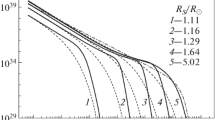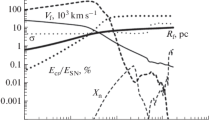Abstract
Numerical simulation of the destruction, evaporation, deceleration, and emission of the Chelyabinsk superbolide has been carried out. The model assumes that the main energy is radiated in the stage when the asteroid is already completely destroyed and does not have solidity (quasi-liquid approximation). The radiation transfer during the motion is taken into account in the approximation of radiative heat conductivity and volumetric emission. The distributions of temperatures and densities are obtained at the moments when the bolide is at different altitudes. The intensity of radiation at the Earth’s surface is calculated at certain times by solving the radiative transfer equation along the rays passing through the luminous region using the air and LL-chondrite vapor absorption coefficients. The features of superbolide radiation, the contribution of air and vapor to radiation, the size of the luminous region, and the radiation spectrum have been considered. The calculated efficiency of radiation—17% of the kinetic energy of a cosmic body—agrees with the results of observations. It is shown that due to anisotropy of the superbolide radiation, the determination of luminous efficiency from measurements can depend on the observation point. For estimations, the pointsource approximation can be used, but in general, the source luminous efficiency is unknown, and its location is determined with some error; therefore, numerical simulation is required to reliably estimate the consequences of space body falls.
Similar content being viewed by others
References
Aftosmis, M.J., Nemec, M., Mathias, D.L., and Berger, M.J., Numerical simulation of bolide entry with ground footprint prediction, Proc. 54th AIAA Aerospace Sciences Meeting, San Diego, 2016, no. AIAA-0998.
Avilova, I.V., Biberman, L.M., Vorob’ev, V.S., Zamalin, V.M., Kobzev, G.A., Lagar’kov, A.N., Mnatsakanyan, A.Kh., and Norman, G.E., Opticheskie svoistva goryachego vozdukha (Optic Properties of Hot Air), Moscow: Nauka, 1970.
Avramenko, M.I., Glazyrin, I.V., Ionov, G.V., and Karpeev, A.V., Simulation of the airwave caused by the Chelyabinsk superbolide, J. Geophys. Res.: Atmos., 2014, vol. 119, pp. 7035–7050. doi 10.1002/2013JD021028
Berezhnoy, A.A. and Borovicka, J., Formation of molecules in bright meteors, Icarus, 2010, vol. 210, pp. 150–157.
Borovicka, J., A fireball spectrum analysis, Astron. Astrophys., 1993, vol. 279, pp. 627–645.
Borovicka, J., Two components in meteor spectra, Planet. Space Sci., 1994, vol. 42, pp. 145–150.
Borovicka, J., and Berezhnoy, A.A., Radiation of molecules in Benesov bolide spectra, Icarus, 2016, vol. 278, pp. 248–265.
Borovicka, J., Spurný, P., Brown, P., Wiegert, P., Kalenda, P., Clark, D., and Shrbený, L., The trajectory, structure and origin of the Chelyabinsk asteroidal impactor, Nature, 2013, vol. 503, pp. 235–237.
Bronshtein, V.A. and Chigorin, A.N., Equilibrium ionization and temperature in a strong shock wave in the air, Teplofiz. Vysok. Temp., 1964, vol. 2, no. 6, pp. 860–868.
Brown, P.G., Spalding, R.E., ReVelle, D.O., Tagliaferri, E., and Worden, S.P., The flux of small near-Earth objects colliding with the Earth, Nature, 2002, vol. 420, pp. 294–296.
Brown, P.G., Assink, J.D., Astiz, L., Blaauw, R., Bolough, M.B., Borovicka, J., Brachet, N., Brown, D., Campbell- Brown, M., Ceranna, L., Cooke, W., de Groot-Hedlin, C., Drob, D.P., Edwards, W., Evers, L.G., et al., A 500-kiloton airburst over Chelyabinsk and an enhanced hazard from small impactors, Nature, 2013, vol. 503, pp. 238–241.
Chyba, C.F., Thomas, P.J., and Zahnle, K.J., The 1908 Tunguska explosion—atmospheric disruption of a stony asteroid, Nature, 1993, vol. 361, pp. 40–44.
Glasstone, S. and Dolan, P.J., The Effects of Nuclear Weapons, Washington, DC: US Dep. Def., Dep. Energy, 1977, 3rd ed.
Gorelov, V.A. and Kireev, A.Yu., Nonequilibrium ionization at high-speed entry of aircraft into the Earth’s atmosphere, Uch. Zap. Tsentr. Aerogidrodin. Inst., 2007, vol. 38, nos. 1–2, pp. 49–58.
Grigoryan, S.S., Movement and destruction of meteorites in planetary atmospheres, Kosm. Issled., 1979, vol. 17, pp. 875–893.
Hills, J.G. and Goda, M.P., The fragmentation of small asteroids in the atmosphere, Astron. J., 1993, vol. 105, pp. 1114–1144.
Ivanov, B.A., Deniem, D., and Neukum, G., Implementation of dynamic strength models into 2D hydrocodes: Applications for atmospheric break up and impact cratering, Int. J. Impact Eng., 1997, vol. 20, pp. 411–430.
Kartashova, A., Popova, O., Jenniskens, P., Emel’yanenko, V., Korotkiy, S., Khaibrakhmanov, S., Dudorov, A., Biryukov, E., Glazachev, D., Trubetskaya, I., and Serdyuk, I., Eye-witness interviews on the Chelyabinsk airburst, Proc. Int. Meteor Conf. Poznan, 2013, pp. 189–192.
Kosarev, I.B., Calculation of the thermodynamic and optical properties of the vapors of the matter of cosmic bodies in the Earth’s atmosphere, Inzh.-Fiz. Zh., 1999, vol. 72, no. 6, pp. 1067–1075.
Kosarev, I.B., The optical properties of vapors of matter of cosmic bodies invading the Earth atmosphere, High Temp., 2009, vol. 47, no. 6, pp. 777–787.
Kuznetsov, N.M., Termodinamicheskie funktsii i udarnye adiabaty vozdukha pri vysokikh temperaturakh (Thermodynamic Functions and Shock Adiabats of Air at High Temperatures), Moscow: Mashinostroenie, 1965.
Laux, C.O., Winter, M., Merrifield, J., Smith, A., and Tran, P., Influence of ablation products on the radiation at the surface of a blunt hypersonic vehicle at 10 km/s, Proc. 41st AIAA Thermophysics Conf., San Antonio, 2009, no. AIAA 2009–3925.
Nemtchinov, I.V., Svetsov, V.V., Kosarev, I.B., Golub’, A.P., Popova, O.P., Shuvalov, V.V., Spalding, R.E., Jacobs, C., and Tagliaferry, E., Assessment of kinetic energy of meteoroids detected by satellite-based light sensors, Icarus, 1997, vol. 130, pp. 259–274.
Pierazzo, E., Vickery, A.M., and Melosh, H.J., A reevaluation of impact melt production, Icarus, 1997, vol. 127, pp. 408–423.
Popova, O.P., Jenniskens, P., Emel’yanenko, V., Kartashova, A., Biryukov, E., Khaibrakhmanov, S., Shuvalov, V., Rybnov, Y., Dudurov, A., Grokhovsky, V.I., Badyukov, D.D., Yin, Q-Z., Gural, P.S., Alberts, J., Gravnik, M., et al., Chelyabinsk airburst, damage assessment, meteorite recovery, and characterization, Science, 2013, vol. 342, pp. 1069–1073.
Schaefer, L. and Fegley, B., Jr., Outgassing of ordinary chondritic material and some of its implications for the chemistry of asteroids, planets, and satellites, Icarus, 2007, vol. 186, pp. 462–483.
Shuvalov, V.V., Multi-dimensional hydrodynamic code SOVA for interfacial flows: application to thermal layer effect, Shock Waves, 1999, vol. 9, no. 6, pp. 381–390.
Shuvalov, V.V. and Artemieva, N.A., Numerical modeling of Tunguska-like impacts, Planet. Space Sci. 2002, vol. 50, pp. 181–192.
Shuvalov, V.V. and Trubetskaya, I.A., Aerial bursts in the terrestrial atmosphere, Sol. Syst. Res. 2007, vol. 41, no. 3, pp. 220–230.
Shuvalov, V.V. and Trubetskaya, I.A., The influence of internal friction on the deformation of a damaged meteoroid, Sol. Syst. Res., 2010, vol. 44, no. 2, pp. 104–109.
Shuvalov, V.V., Svettsov, V.V., Popova, O.P., and Glazachev, D.O., Use of the liquid model for simulation of the Chelyabinsk event, in Dinamicheskie protsessy v geosferakh (Dynamics in Geospheres), Sb. Nauch. Tr. Inst. Din. Geosfer, Ross. Akad. Nauk, Moscow: GEOS, 2016a, no. 8, pp. 184–197.
Shuvalov, V.V., Popova, O.P., Svettsov, V.V., Trubetskaya, I.A., and Glazachev, D.O., Determination of the height of the “meteoric explosion,” Sol. Syst. Res., 2016b, vol. 50, no. 1, pp. 1–12.
Shuvalov, V., Svetsov, V., Popova, O., and Glazachev, D., Numerical model of the Chelyabinsk meteoroid as a strengthless object, Planet. Space Sci., 2017, vol. 147, pp. 38–47.
Svettsov, V.V., An economical numerical method for onedimensional problems of radiation gas dynamics, Zh. Vychisl. Mat. Mat. Fiz., 1994a, vol. 34, no. 3, pp. 432–445.
Svettsov, V.V., Explosions in the lower and middle atmosphere: a spherically symmetric stage, Fiz. Goreniya Vzryva, 1994b, vol. 30, no. 5, pp. 129–142.
Tagliaferri, E., Spalding, R., Jacobs, C., Worden, S.P., and Erlich, A., Detection of meteoroid impacts by optical sensors in Earth orbit, in Hazards Due to Comets and Asteroids, Tucson: Univ. Arizona Press, 1994, pp. 199–220.
Thompson, S.L. and Lauson, H.S., Improvements in the Chart D Radiation-Hydrodynamic CODE III: Revised Analytic Equations of State, Report SC-RR-710714, Albuquerque: Sandia National Lab., 1972.
Vasil’ev, N.V., Tungusskii meteorit. Kosmicheskii fenomen leta 1908 g. (Tunguska Meteorite: Space Phenomena of Summer 1908), Moscow: Russkaya Panorama, 2004.
Zel’dovich, Ya.B. and Raizer, Yu.P., Fizika udarnykh voln i vysokotemperaturnykh gidrodinamicheskikh yavlenii (Physics of Hit Waves and High-Temperature Hydrodynamic Phenomena), Moscow: Fizmatlit, 1966.
Author information
Authors and Affiliations
Corresponding author
Additional information
Original Russian Text © V.V. Svettsov, V.V. Shuvalov, O.P. Popova, 2018, published in Astronomicheskii Vestnik, 2018, Vol. 52, No. 3, pp. 201–212.
Rights and permissions
About this article
Cite this article
Svettsov, V.V., Shuvalov, V.V. & Popova, O.P. Radiation from a Superbolide. Sol Syst Res 52, 195–205 (2018). https://doi.org/10.1134/S0038094618020065
Received:
Published:
Issue Date:
DOI: https://doi.org/10.1134/S0038094618020065




